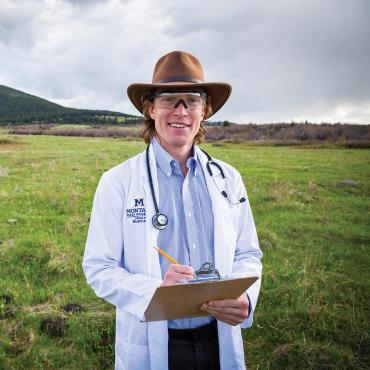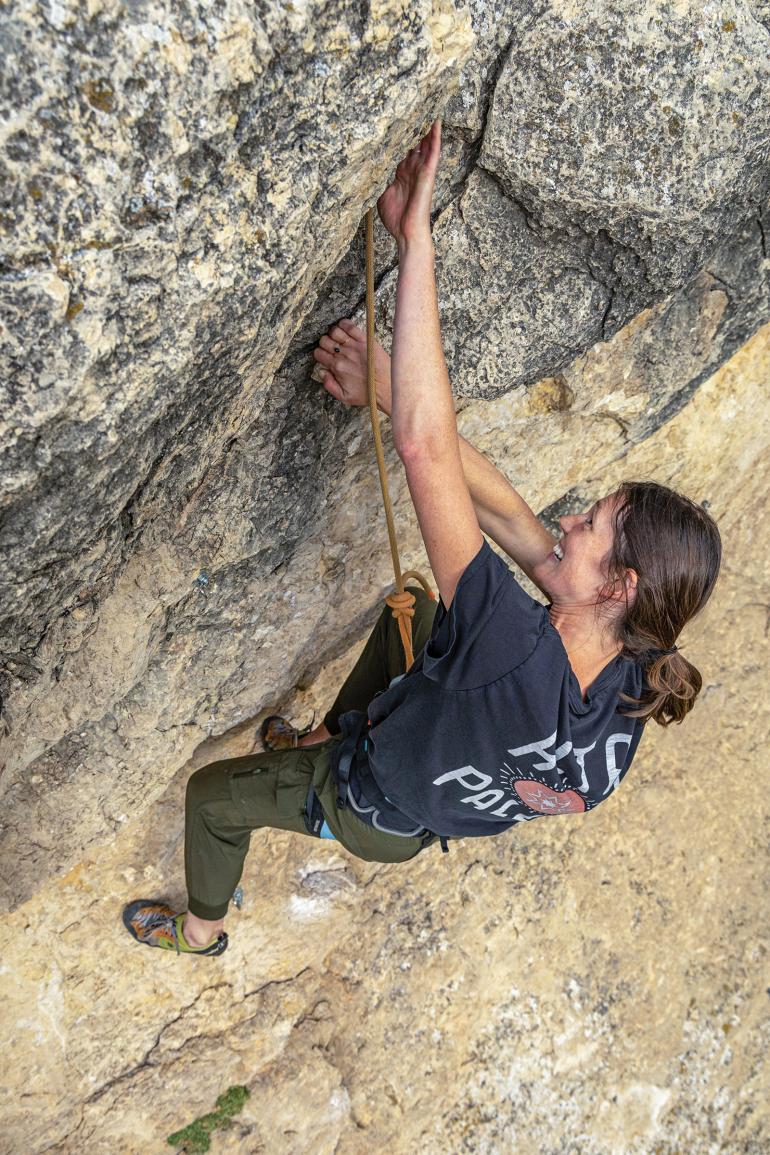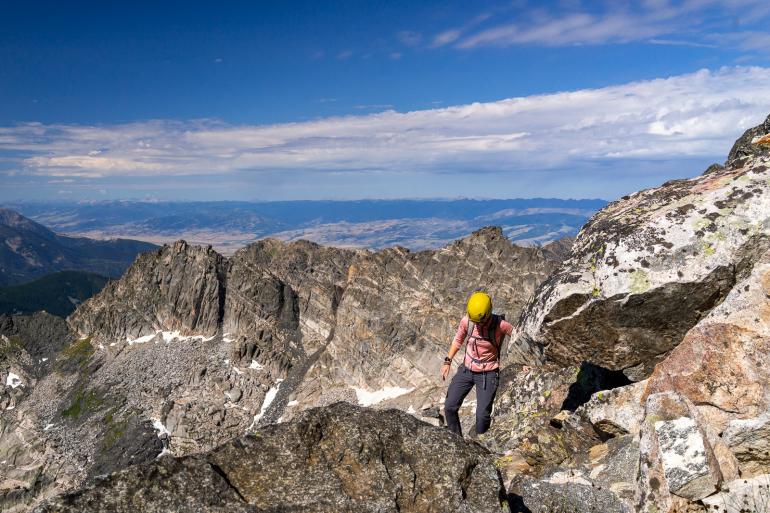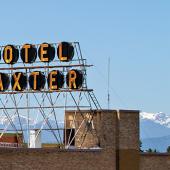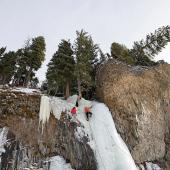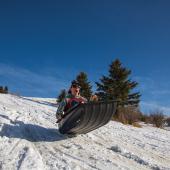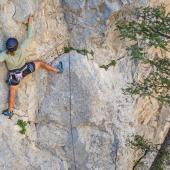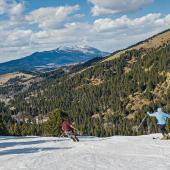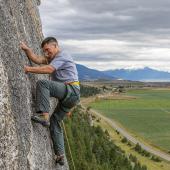School of Rock
Roping up near Bozeman.
Climbing has a long, rich history in Bozeman’s outdoor culture. The adventurous ascender will find a lifetime of opportunities to explore different types of stone in a variety of environments, from roadside limestone clip-ups to soaring granite ridges high in the alpine. And despite our northern climate, the season here runs relatively long—we even have a few cliffs that are warm enough to climb on a sunny day in mid-winter (if you’re not into ice climbing, that is). You’ll find solitude at all but the most popular crags, so don’t be afraid to venture off the beaten path. Just make sure you’ve got a good pair of trail shoes or hiking boots—Montana is known for having long approaches, but the walk is always worth it.
Where to Go
No matter what kind of outing you’re after, you’ll find it within a short drive from town. Looking for boulder problems? In the warmer seasons, check out the Nunnery and Cascade Creek up Gallatin Canyon, or the Overhangatang boulders in Hyalite Canyon. For the colder seasons, a near-limitless expanse of boulders spans between Pipestone and Homestake Pass.
For sport climbing, Bear Canyon, Bozeman Pass, and Allenspur offer a wide selection of routes on quality stone ranging from 5.7 to 5.12. Scorched Earth is also easily accessible, and while you won’t find anything easier than 5.10 here, it’s a great place to soak up some sun in the colder months. If you’re willing to walk a bit farther, Wolverine Bowl in the Bridgers has the best limestone around, and a bit farther north, Ross Peak offers soaring multipitch sport climbs on rock of variable quality. Just make sure you’re up for the challenge—this can turn into a big day.
If you’re after an alpine experience, southwest Montana’s high peaks offer tons of big climbs in remote settings guarded by burly approaches.
Options open up even more for trad climbing. Practice Rock has climbs of all difficulties, with sun or shade, and is the closest crag to Bozeman. Depending on your ability, check out Strawberry Crack (5.7), Wizard’s Well (5.9+), Theoretically (5.10c), or Tough Trip Through Paradise (5.11c). Any of these climbs can be top-roped by walking to the top of the cliff and building an anchor. Next up, Gallatin Canyon is the crown jewel of Bozeman rock climbing. With hundreds of single- and multipitch climbs on solid gneiss, this is a great place to progress as a climber. Make sure to start out easy—grades here are often sandbagged. Not to be missed are Skyline Arete (5.6, six pitches), Gallatin Tower Standard Route (5.8, three pitches), Sparerib (5.8, two pitches), Diesel Driver (5.9+), Blackline (5.10b), Sky King (5.11b), and The Fugitive (5.12b). For shoulder-season climbing when the Canyon can have cold temps and wet rock, head out to Spire Rock in Pipestone for tons of crack climbing in a drier environment.
If you’re after an alpine experience, southwest Montana’s high peaks offer tons of big climbs in remote settings guarded by burly approaches. Be prepared to encounter route-finding challenges, loose rock, and complicated descents. Beehive Peak has a few routes that’ll test your skills. The Cowen Massif has some serious alpine rock climbs if you’re feeling up to it, including the Standard Route (4th class with one pitch of 5.4) to Mt. Cowen’s 11,206-foot summit, and the ultra-classic Montana Centennial Route (5.11b, 12 pitches) on Eenie Spire. Beyond that, the Beartooth Mountains hold many obscurities that’ll challenge even the savviest alpinists—we’ll leave the research to you.
Essential Gear
To start out, you’ll need a well-fitting pair of rock shoes. For new gear, Uphill Pursuits is our premier local climbing retailer, while Spire Climbing Center has a full pro shop. Both Spire and Second Wind Sports carry a large selection of consignment shoes. If you need a cheap chalkbag, Spire sells lost-and-found languishers for pennies on the dollar. With these two items, you’ll be ready to tag along with a buddy who has more gear—though having one’s own harness is an important step on the way to self-sufficiency.
If you want to take things to the next level, there are a few different options to consider. For bouldering, pick up a crash-pad or two and you’re all set. If roped climbing is what you’re after, get a rope around 9.5-10mm in diameter—relatively thick for extra durability as you figure things out. Next, pick up a comfortable harness and helmet; it pays to try them on before you buy. A belay device, cordelette, and a couple of locking and non-locking carabiners will let you set up top-ropes at crags where you can walk to the top, such as Practice Rock and Pipestone. Add in a dozen quickdraws, and you’re ready to tackle all the sport climbs on our expansive limestone cliffs.
When it’s time to get more adventurous, invest in a selection of cams and stoppers for traditional climbing. These can get spendy, but you can save by splitting the cost with a climbing partner.
In general, be cautious of buying used climbing gear. Metal items like carabiners, cams, and stoppers are generally okay because they last a long time and are easy to assess for damage, but never buy a used rope, harness, cordelette, or quickdraws unless you trust the previous owner with your life and know that the gear has been well taken care of.
Etiquette
We all have an obligation to care for our recreation spaces, and climbing areas are no exception. Though overcrowding is generally not an issue at most of our crags, some popular places such as Practice Rock, Bear Canyon, Gallatin Tower, and Allenspur can get busy. If you find yourself at a busy crag, be courteous to fellow climbers and respect their space. If a climb is occupied, politely wait for the party to finish, or find another route—no one wants to feel pressured. Don’t play music if other people are around. As with any outdoor activity, follow “Leave No Trace” principles to keep our crags as close to their natural state as possible. If you have a dog, make sure he’s well-behaved and isn’t bothering any other climbers—or other dogs, for that matter. And please, for the sake of us all, have a plan for when nature calls. Keep human (and canine) excrement far away from the base of climbs. If there isn’t an outhouse at the trailhead, take a long walk and dig a hole, or pack it out.

